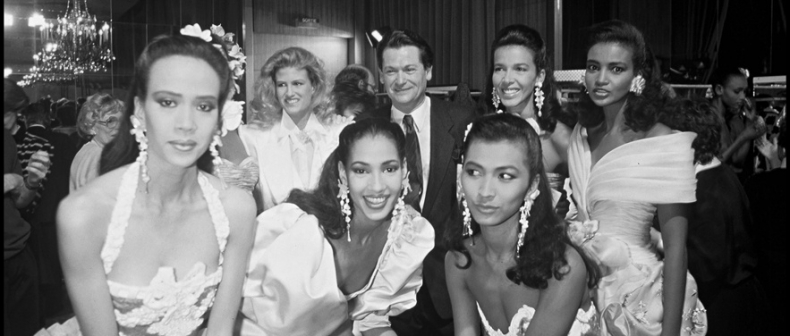
Photo: French Vogue
If you’re interested in fashion, you must recognize a lot of labels and remember a bunch of names. They’re not always the same thing. With only a vague knowledge of a label you can bluff and pass yourself off as an expert, as a female buyer did when asked about Proenza Schouler in the documentary Seamless. But chances are you’ll be found out–she went on to refer to the label’s designer duo, Jack McCollough and Lazaro Hernandez, with the singular “he.” I’ve had to remember that it’s Hedi Slimane with one ‘I’ and not two because he’s a man, not a little Swiss girl. And Greta Constantine is not only not a woman, but two men. The general public thinks fashion writers memorize types of fabric and shapes of sleeves–in reality, it’s all about collecting names.
I’ll admit when I saw the headlines (or, let’s be honest, the tweets) announcing that fashion designer Jean-Louis Scherrer died at age 78, I asked ‘Who?’ Nothing in my mind connected his name to Parisian couture. Many obituaries highlighted Jackie Kennedy Onassis as a client, but he didn’t shape her look as much as Oleg Cassini or Halston, who designed the famed pillbox hats including the pale pink one she wore in Dallas.
What interested me most from the maddeningly short summaries of Scherrer’s life was the revelation he was the first haute couture designer fired from his eponymous label. But all the obits refused to say why. Was there some terrible scandal, some cause célèbre the fashion world is still yet to fully recover from? The answer appeared shrouded in gauzy mystery. Scherrer doesn’t even have a Wikipedia entry, at least not in English. I mean, seriously–I have ex-boyfriends with Wikipedia entries. (Well, one…I shouldn’t go into it.)
Although trained as a dancer, Jean-Louis Scherrer at age 19 was incredibly fortunate to become an assistant to Christian Dior during the height of his fame and influence. After the designer’s untimely death in 1957, Scherrer stayed on at the company with Yves Saint Laurent for two years. After a brief stint with Louis Feraud he founded his own label in 1962.
Known for his “classic, restrained, sophisticated, and sexy” looks, he attracted a clientele of movie stars (Raquel Welch, Sophia Loren), socialites (Nan Kempner), and royals (Queen Noor of Jordan). He wasn’t a fashion-forward trendsetter but a purveyor of luxurious fabrics, classic cuts, and reliable good taste. This reputation was helpful when he moved into ready-to-wear with moderately priced blazers and chiffon dresses, available in America at stores like Bergdorf Goodman.
But the 1970’s and 1980’s were a difficult time for haute couture. The world economy was in flux and the courtiers with their teams of hand-sewing ateliers and fashion houses piled high with traditions appeared as if from another century. Although Scherrer diversified his company by getting into perfumes and fur, the label had difficulty turning a profit. During the 1980’s the company had annual sales of about $25 million, but was operating at a loss of $7 million. In 1990 a Japanese firm named the Sebu-Saison Group acquired 90 percent of the company and thought the buck stopped at the designer. Scherrer had employed his daughter Laetitia as a model and muse. The new management fired her.
Then, right before starting work on his spring 1993 couture collection, Scherrer arrived at his office to find a letter dismissing him from his own label. The fashion world was shocked. Scherrer received a phone call of condolence from the wife of the French president. According to the designer, his initial pay off only amounted to one month’s salary.
“I was fired like a street-sweeper,” he said at the time. “No, even a street-sweeper when he’s fired gets a warning.”
So poorly treated, Scherrer didn’t mind airing his dirty couture in public. “I don’t know what Erik Mortensen understands about my style,” he told Women’s Wear Daily about the designer who replaced him. He took Sebu-Saison to court, eventually winning a larger settlement but not the use of his name.
An interesting contemporary account from British newspaper The Independent puts the trials of Scherrer into the context of the decline of French couture.
“The truth is,” wrote Roger Tredre, “the financial giants behind most of the Paris couturiers are now increasingly reluctant to pour money into the most expensive promotions on earth.” Tredre pointed out that couture, as expensive to make as it is to buy, was only hanging on as a means to publicize fashion houses’ lines of perfumes and beauty products. “Only a few thousand women worldwide can afford to buy couture, and even that small number is dwindling. Scherrer used to dress dozens of women in the Middle East…the Gulf War was a catastrophe for his business.” The opulent eighties over, even the ladies who lunch were dressing down.
Tredre managed to be both prescient and wrong. “If there is a future for couture,” he wrote, “it may, ironically, lie in the approach offered by a handful of British couturiers.” Sure enough, by the mid to late-1990’s Alexander McQueen helped revive Givenchy after fellow Brit John Galliano moved to Dior. But they didn’t breath new life into couture in the manner Tredre had predicted–“discreet salon shows for a few special clients, unspectacular collections that don’t try to grab headlines.”
In fact, the opposite happened. McQueen and Galliano were fantastic for the industry because they created spectaculars that grabbed headlines. Couture looks may no longer trickle down to the masses through Bergdorf Goodman, but the theatrical runway shows create unmatchable publicity for companies’ purses, makeup, and perfumes. What Tredre missed–economies rebound and ostentation always comes back in style.
As for Jean-Louis Scherrer the company, it cycled through a series of designers and financial backers before closing shop in 2007, although the label is still licensed for products. I’ll admit to being a bit disappointed Scherrer’s dismissal wasn’t the salacious scandal I concocted in my imagination. But the real story is more illustrative of the industry’s paradoxes. Fashion designers, who always share creativity and a commitment to beauty, toil their entire careers to turn their names into labels recognized the world over. But with success comes the arrival of people who care more about bottom lines than hemlines, who make decisions based on commerce and not art. I can only imagine how difficult it must have been for Scherrer to see his company, still under his name, go on without him. I wonder if he would have preferred to be a dancer.
____
Max Mosher writes about style for Toronto Standard. You can follow him on Twitter at @max_mosher_.
For more, follow us on Twitter @TorontoStandard or subscribe to our newsletter.














